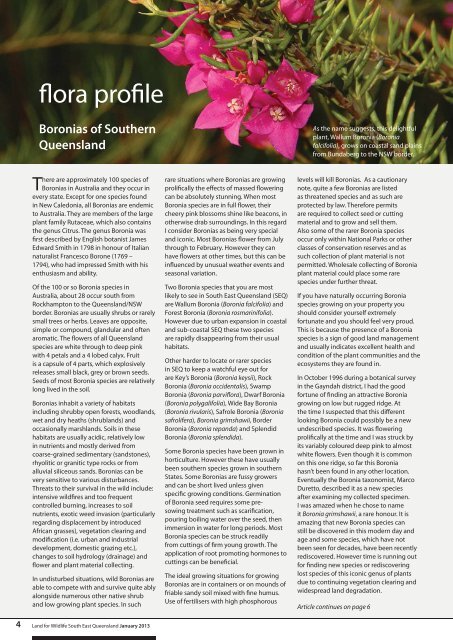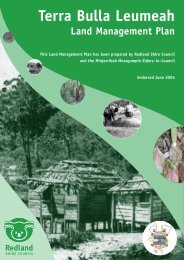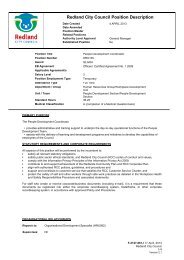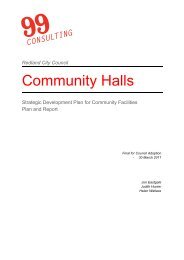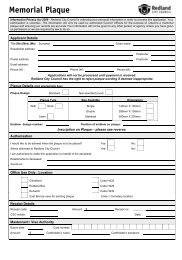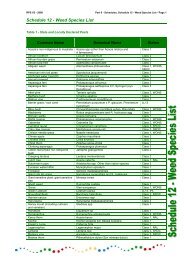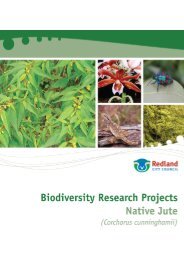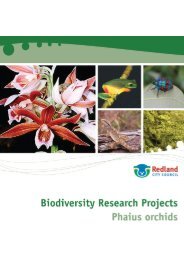Land for Wildlife Newsletter - IndigiScapes
Land for Wildlife Newsletter - IndigiScapes
Land for Wildlife Newsletter - IndigiScapes
You also want an ePaper? Increase the reach of your titles
YUMPU automatically turns print PDFs into web optimized ePapers that Google loves.
flora profile<br />
Boronias of Southern<br />
Queensland<br />
As the name suggests, this delightful<br />
plant, Wallum Boronia (Boronia<br />
falcifolia), grows on coastal sand plains<br />
from Bundaberg to the NSW border.<br />
There are approximately 100 species of<br />
Boronias in Australia and they occur in<br />
every state. Except <strong>for</strong> one species found<br />
in New Caledonia, all Boronias are endemic<br />
to Australia. They are members of the large<br />
plant family Rutaceae, which also contains<br />
the genus Citrus. The genus Boronia was<br />
first described by English botanist James<br />
Edward Smith in 1798 in honour of Italian<br />
naturalist Francesco Borone (1769 –<br />
1794), who had impressed Smith with his<br />
enthusiasm and ability.<br />
Of the 100 or so Boronia species in<br />
Australia, about 28 occur south from<br />
Rockhampton to the Queensland/NSW<br />
border. Boronias are usually shrubs or rarely<br />
small trees or herbs. Leaves are opposite,<br />
simple or compound, glandular and often<br />
aromatic. The flowers of all Queensland<br />
species are white through to deep pink<br />
with 4 petals and a 4 lobed calyx. Fruit<br />
is a capsule of 4 parts, which explosively<br />
releases small black, grey or brown seeds.<br />
Seeds of most Boronia species are relatively<br />
long lived in the soil.<br />
Boronias inhabit a variety of habitats<br />
including shrubby open <strong>for</strong>ests, woodlands,<br />
wet and dry heaths (shrublands) and<br />
occasionally marshlands. Soils in these<br />
habitats are usually acidic, relatively low<br />
in nutrients and mostly derived from<br />
coarse-grained sedimentary (sandstones),<br />
rhyolitic or granitic type rocks or from<br />
alluvial siliceous sands. Boronias can be<br />
very sensitive to various disturbances.<br />
Threats to their survival in the wild include:<br />
intensive wildfires and too frequent<br />
controlled burning, increases to soil<br />
nutrients, exotic weed invasion (particularly<br />
regarding displacement by introduced<br />
African grasses), vegetation clearing and<br />
modification (i.e. urban and industrial<br />
development, domestic grazing etc.),<br />
changes to soil hydrology (drainage) and<br />
flower and plant material collecting.<br />
In undisturbed situations, wild Boronias are<br />
able to compete with and survive quite ably<br />
alongside numerous other native shrub<br />
and low growing plant species. In such<br />
rare situations where Boronias are growing<br />
prolifically the effects of massed flowering<br />
can be absolutely stunning. When most<br />
Boronia species are in full flower, their<br />
cheery pink blossoms shine like beacons, in<br />
otherwise drab surroundings. In this regard<br />
I consider Boronias as being very special<br />
and iconic. Most Boronias flower from July<br />
through to February. However they can<br />
have flowers at other times, but this can be<br />
influenced by unusual weather events and<br />
seasonal variation.<br />
Two Boronia species that you are most<br />
likely to see in South East Queensland (SEQ)<br />
are Wallum Boronia (Boronia falcifolia) and<br />
Forest Boronia (Boronia rosmarinifolia).<br />
However due to urban expansion in coastal<br />
and sub-coastal SEQ these two species<br />
are rapidly disappearing from their usual<br />
habitats.<br />
Other harder to locate or rarer species<br />
in SEQ to keep a watchful eye out <strong>for</strong><br />
are Key’s Boronia (Boronia keysii), Rock<br />
Boronia (Boronia occidentalis), Swamp<br />
Boronia (Boronia parviflora), Dwarf Boronia<br />
(Boronia polygalifolia), Wide Bay Boronia<br />
(Boronia rivularis), Safrole Boronia (Boronia<br />
safrolifera), Boronia grimshawii, Border<br />
Boronia (Boronia repanda) and Splendid<br />
Boronia (Boronia splendida).<br />
Some Boronia species have been grown in<br />
horticulture. However these have usually<br />
been southern species grown in southern<br />
States. Some Boronias are fussy growers<br />
and can be short lived unless given<br />
specific growing conditions. Germination<br />
of Boronia seed requires some presowing<br />
treatment such as scarification,<br />
pouring boiling water over the seed, then<br />
immersion in water <strong>for</strong> long periods. Most<br />
Boronia species can be struck readily<br />
from cuttings of firm young growth. The<br />
application of root promoting hormones to<br />
cuttings can be beneficial.<br />
The ideal growing situations <strong>for</strong> growing<br />
Boronias are in containers or on mounds of<br />
friable sandy soil mixed with fine humus.<br />
Use of fertilisers with high phosphorous<br />
levels will kill Boronias. As a cautionary<br />
note, quite a few Boronias are listed<br />
as threatened species and as such are<br />
protected by law. There<strong>for</strong>e permits<br />
are required to collect seed or cutting<br />
material and to grow and sell them.<br />
Also some of the rarer Boronia species<br />
occur only within National Parks or other<br />
classes of conservation reserves and as<br />
such collection of plant material is not<br />
permitted. Wholesale collecting of Boronia<br />
plant material could place some rare<br />
species under further threat.<br />
If you have naturally occurring Boronia<br />
species growing on your property you<br />
should consider yourself extremely<br />
<strong>for</strong>tunate and you should feel very proud.<br />
This is because the presence of a Boronia<br />
species is a sign of good land management<br />
and usually indicates excellent health and<br />
condition of the plant communities and the<br />
ecosystems they are found in.<br />
In October 1996 during a botanical survey<br />
in the Gayndah district, I had the good<br />
<strong>for</strong>tune of finding an attractive Boronia<br />
growing on low but rugged ridge. At<br />
the time I suspected that this different<br />
looking Boronia could possibly be a new<br />
undescribed species. It was flowering<br />
prolifically at the time and I was struck by<br />
its variably coloured deep pink to almost<br />
white flowers. Even though it is common<br />
on this one ridge, so far this Boronia<br />
hasn’t been found in any other location.<br />
Eventually the Boronia taxonomist, Marco<br />
Duretto, described it as a new species<br />
after examining my collected specimen.<br />
I was amazed when he chose to name<br />
it Boronia grimshawii, a rare honour. It is<br />
amazing that new Boronia species can<br />
still be discovered in this modern day and<br />
age and some species, which have not<br />
been seen <strong>for</strong> decades, have been recently<br />
rediscovered. However time is running out<br />
<strong>for</strong> finding new species or rediscovering<br />
lost species of this iconic genus of plants<br />
due to continuing vegetation clearing and<br />
widespread land degradation.<br />
Article continues on page 6<br />
4<br />
<strong>Land</strong> <strong>for</strong> <strong>Wildlife</strong> South East Queensland January 2013


